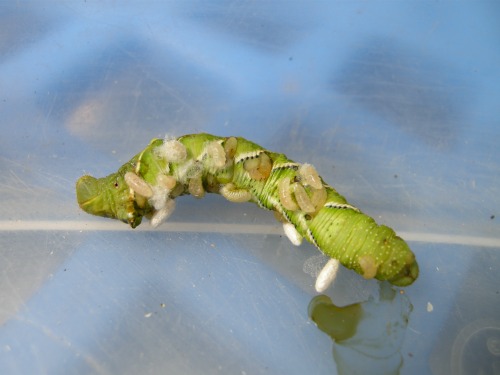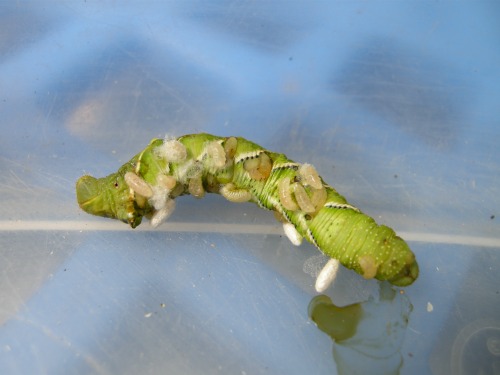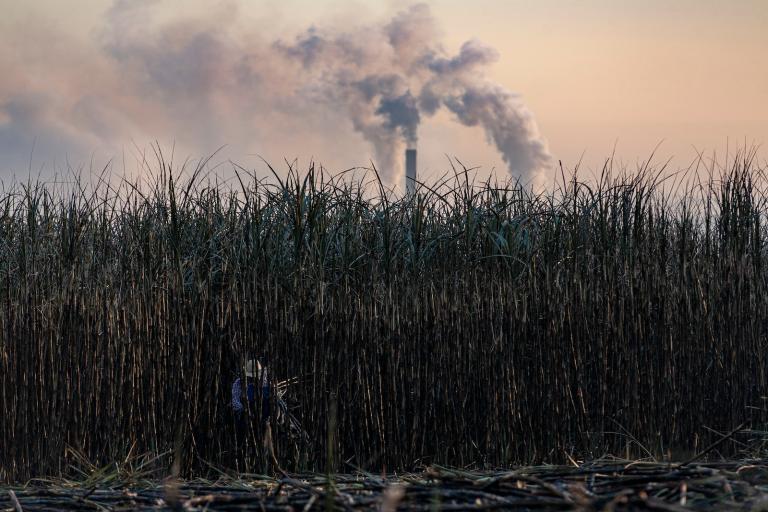Food Studies features the voices of 11 volunteer student bloggers from a variety of different food- and agriculture-related programs at universities around the world. You can explore the full series here.
 Photo: Josh EvansTo the right is a tomato hornworm — a common pest of tomato plants throughout much of North America. While gardeners and farmers will comb their rows, picking them off stems and leaves, sometimes a more efficient predator gets to them first. The brachonid wasp found this particular specimen ripe for the taking. The wasp lays its eggs inside the hornworm, and when the larvae hatch, they eat their way out while the worm is still alive, form cocoons on its surface, and use it as a stable vehicle while they mature into adult wasps.
Photo: Josh EvansTo the right is a tomato hornworm — a common pest of tomato plants throughout much of North America. While gardeners and farmers will comb their rows, picking them off stems and leaves, sometimes a more efficient predator gets to them first. The brachonid wasp found this particular specimen ripe for the taking. The wasp lays its eggs inside the hornworm, and when the larvae hatch, they eat their way out while the worm is still alive, form cocoons on its surface, and use it as a stable vehicle while they mature into adult wasps.
I have been working with the Yale Sustainable Food Project for over two years now, mostly planning events and working on the cooking and hosting side of things. This year, I wanted to delve into the growing side — the soil-level cycles that bring produce to the table and ultimately become, say, pizza from the oven. I know that sustainable, biodynamic agriculture is based on reconnecting with the complex systems that regulate the natural world, and I had already felt the intense gratification that these connections bring. What I hadn’t expected is nature’s brutal side.
During a recent workday, Daniel, the head farm manager, showed me this hornworm, which he had found on a tomato plant. The larvae writhed in all directions, sprouting out of the worm’s green flesh like disembodied finger puppets. I was fascinated but also horrified. I have caught, killed, and gutted my own fish, as well as wrenched sheaves of weeds from the ground in my time, so I knew it wasn’t simply a matter of an inability to face suffering. I looked to Daniel, one of the gentlest people I know, for a cue, an explanation. He was quietly absorbed, not a whit of revulsion, confusion, or remorse on his face.
I kept the hornworm close by in a plastic container as I processed salad greens and radishes, studying it over the course of the afternoon. It twisted less and less each time I nudged the container, dying slowly as the parasitic larvae grew and spun their small cocoons.
I already knew that nature doesn’t follow our rules; it doesn’t respond to concepts of “nice” or “fair” or “kind” (lessons learned in childhood). But here was a reminder of something greater, a response to what we mean when we say “sustainable agriculture.” There are no opposing teams in this process; there can be no “us” versus “them,” really. There are players interacting in a system, through cycles of production and consumption. A system is healthy when these forces are in balance, and it is the farmer’s vocation to understand these incredibly many forces and their complex interactions, and to use them to provide for himself and others while maintaining the health of the system that sustains us. Not a simple task, but definitely an immensely gratifying one.
My initial response to the sight of the brachonid larvae feeding on the live hornworm — visceral disgust and horror — was understandable. But as I pulled radishes out of the ground and cut leaves from living plants, I couldn’t help but wonder how my enjoyment of freshly harvested butter lettuce or eggs from our lovely laying hens compared to the larvae roiling out of the hornworm. Self-interest dominates consumption — but does that also make it inherently wrong?
Sustainable agriculture has taught me many things, not least of which is that health is best measured systemically. We do not mind a couple eggplants succumbing to pests after heavy rain, or a handful of hornworms trolling our tomato vines (though we will pick them off if we see them). There will always be other creatures and forces undoing our work, other living beings that we call “pests.” We are concerned less with the acute than the chronic — an entire crop of eggplant rotting from the inside, or a swarm of hornworms ruining a field of tomatoes. These are signs that the system is out of balance, and it is our job, with our intellect and agency, to figure out how these phenomena are linked and then to shift them back into a more desirable balance.
Eventually, I realized that the parasite-colonized hornworm was also a sign — but a sign of a healthy system, where one consumer also provides for other consumers, and where these relationships enhance the system as a whole. The entire endeavor of farming is certainly rooted in human self-interest, but at its best, it can enrich and diversify the land and its systems in a way it might not even have been had we left it alone.
 Farming is one of the most devastating ways we have changed the planet for the worse. I believe it is also the most significant way we can change it for the better. The hornworm and the brachonids have a place in that system just as much as the tomato I coax from the soil to sustain me.
Farming is one of the most devastating ways we have changed the planet for the worse. I believe it is also the most significant way we can change it for the better. The hornworm and the brachonids have a place in that system just as much as the tomato I coax from the soil to sustain me.
Happily, I am able to mull these questions over at the end of a workday with a slice of pizza in hand. This particular specimen features ricotta cheese, homemade blueberry syrup, and crisped sage. No hornworms were harmed in the making.



